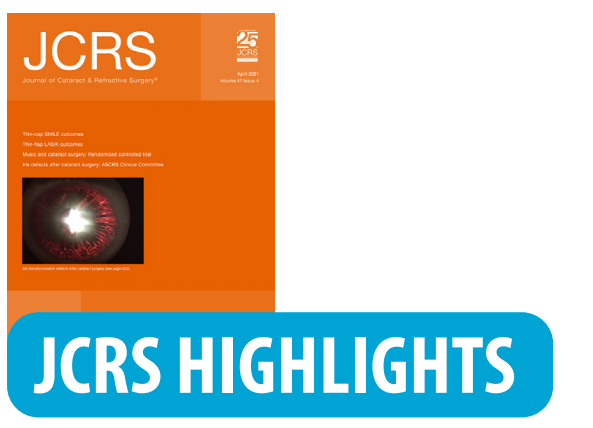JCRS Highlights
VOL: 47 ISSUE: 4 MONTH: APRIL 2021

 IOL POWER CALCULATION POST-LASIK
Finding the best approach to power calculation in cataract patients who have previously undergone myopic LASIK or photorefractive keratectomy is a challenge. US researchers reviewed the charts of 101 eyes of consecutive patients undergoing cataract surgery. They found that even after normalisation of results, the use of total keratometry did not seem to materially improve IOL sphere power calculations in these eyes. Intraoperative aberrometry also did not appear to improve results. Rather, the review suggested that it might be best to use the Haigis-L or Barrett True-K formulas from the ASCRS website with AK values as the input. This would be expected to minimise (but not eliminate) the likelihood of refractive surprises, although it would not be an optimal strategy for reducing outliers.
H Sandoval et al., “Cataract surgery after myopic laser in situ keratomileusis: objective analysis to determine best formula and keratometry to use”, Vol 47, Issue 4, 465-47.
SMILE AND BINOCULAR FUNCTION IN HIGH MYOPIA
The effect of small-incision lenticule extraction (SMILE®) for high myopia on patients’ binocular vision has been an open question. In a study of 138 eyes of 69 patients with high myopia, SMILE did not appear to alter binocular vision. Stereoacuity was assessed through two tests: the Randot Circles (Stereo Optical Company) and the (near) Frisby Stereotest (Clement Clarke). While mean spherical equivalent improved from a mean of -7.46 to -0.23 following surgery, stereoacuity did not change significantly. Binocular visual acuity, binocular contrast sensitivity and binocular summation were also unchanged. The researchers conclude that patients with high myopia that are undergoing SMILE can be informed that SMILE will not affect binocular function.
Gyldenkerne et al., “Impact on binocular visual function of small-incision lenticule extraction for high myopia”, Vol 47, Issue 4, 430-438.
MUSIC HATH CHARMS TO SOOTHE THE CATARACT PATIENT
Recorded music could help first-time patients relax before, during and after phacoemulsification surgery, according to recent prospective, single-masked, randomised controlled trial. One hundred and sixty-five patients listened to music on an MP3 player pre- and perioperatively while an identical number had surgery without music. Only 4% of patients in the musical intervention group reported feeling anxious before surgery compared with 30% in the control group. The patients who were allowed to listen to music had significantly lower systolic and diastolic blood pressures in the postoperative period. This suggests that music can be an inexpensive and effective method to improve the patient experience of cataract surgery, the researchers report.
SK Muddana et al., “Preoperative and perioperative music to reduce anxiety during first-time phacoemulsification cataract surgery in the high-volume setting: randomized controlled trial”, Vol 47, Issue 4, 471-475.
JCRS is the official journal of ESCRS and ASCRS
IOL POWER CALCULATION POST-LASIK
Finding the best approach to power calculation in cataract patients who have previously undergone myopic LASIK or photorefractive keratectomy is a challenge. US researchers reviewed the charts of 101 eyes of consecutive patients undergoing cataract surgery. They found that even after normalisation of results, the use of total keratometry did not seem to materially improve IOL sphere power calculations in these eyes. Intraoperative aberrometry also did not appear to improve results. Rather, the review suggested that it might be best to use the Haigis-L or Barrett True-K formulas from the ASCRS website with AK values as the input. This would be expected to minimise (but not eliminate) the likelihood of refractive surprises, although it would not be an optimal strategy for reducing outliers.
H Sandoval et al., “Cataract surgery after myopic laser in situ keratomileusis: objective analysis to determine best formula and keratometry to use”, Vol 47, Issue 4, 465-47.
SMILE AND BINOCULAR FUNCTION IN HIGH MYOPIA
The effect of small-incision lenticule extraction (SMILE®) for high myopia on patients’ binocular vision has been an open question. In a study of 138 eyes of 69 patients with high myopia, SMILE did not appear to alter binocular vision. Stereoacuity was assessed through two tests: the Randot Circles (Stereo Optical Company) and the (near) Frisby Stereotest (Clement Clarke). While mean spherical equivalent improved from a mean of -7.46 to -0.23 following surgery, stereoacuity did not change significantly. Binocular visual acuity, binocular contrast sensitivity and binocular summation were also unchanged. The researchers conclude that patients with high myopia that are undergoing SMILE can be informed that SMILE will not affect binocular function.
Gyldenkerne et al., “Impact on binocular visual function of small-incision lenticule extraction for high myopia”, Vol 47, Issue 4, 430-438.
MUSIC HATH CHARMS TO SOOTHE THE CATARACT PATIENT
Recorded music could help first-time patients relax before, during and after phacoemulsification surgery, according to recent prospective, single-masked, randomised controlled trial. One hundred and sixty-five patients listened to music on an MP3 player pre- and perioperatively while an identical number had surgery without music. Only 4% of patients in the musical intervention group reported feeling anxious before surgery compared with 30% in the control group. The patients who were allowed to listen to music had significantly lower systolic and diastolic blood pressures in the postoperative period. This suggests that music can be an inexpensive and effective method to improve the patient experience of cataract surgery, the researchers report.
SK Muddana et al., “Preoperative and perioperative music to reduce anxiety during first-time phacoemulsification cataract surgery in the high-volume setting: randomized controlled trial”, Vol 47, Issue 4, 471-475.
JCRS is the official journal of ESCRS and ASCRS